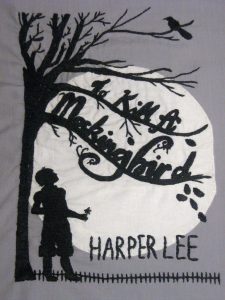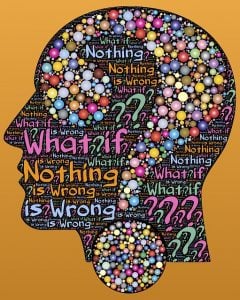Ever watch one of those home decorating shows where the decorator asks, “What sort of theme do you want to go with?”
The decorator is essentially asking about theme because he wants to know whether he should use elements of early modern, colonial, or maybe contemporary design to tie everything together to create that cozy, mountain retreat.
In a sense, literature is sort of like decorating. Decorators need themes to tie the elements of a room together. Similarly, writers include a theme (or several themes) to tie ideas in literature together.
So what, exactly, is a theme in literature? A theme is the underlying meaning of a literary work. It’s what the author is trying say by writing the piece.
A theme is not simply a plot summary or what the literary work is about.
Thus, even if you read To Kill a Mockingbird, it could very well mean that you know all about Jem, Scout, Atticus, and Boo Radley and could write a superb summary of the book.
But you might not be sure what to write if you’re assigned to write a paper about the themes in To Kill a Mockingbird.
If you’ve found yourself in this very situation, here are three themes in To Kill a Mockingbird to help you get started.

3 Important Themes in To Kill a Mockingbird
There’s a lot going on in this book, so don’t assume that the three themes I’ve included here are the only important themes. These are simply the three we’ll discuss. (Here are a few other themes if the themes in my post don’t work for you.)
Before we discuss the actual themes of the novel, here are a few additional tips to keep in mind when writing your paper.
If you’re writing about themes in To Kill a Mockingbird, you’re most certainly writing a literary analysis. That means that you need read the book closely, so it wouldn’t hurt to take a few notes as you read (or re-read).
You should also make sure you have evidence to support your analysis. (You know, stuff like examples from the story and quotes from the characters.)
If you need a little more help with the finer points of writing about literature, read 8 Components of a Smart Literary Analysis before starting your essay.
With these quick literary analysis tips in mind, take a look at the following three important themes in To Kill a Mockingbird for a little writing inspiration.
Theme #1: Morality
We all know that people can be judgmental, racist, and even lacking in any moral code. The characters in To Kill a Mockingbird are no different.
Atticus Finch, however, is the one character who continuously displays a strong sense of morality throughout the story. He also helps establish a moral code for his children, Jem and Scout.
Throughout the novel, Atticus emphasizes the fact that people should not judge others by appearance and should not judge others if they do not know their situations.
Words of wisdom about morality from Atticus Finch:
“Are you proud of yourself tonight that you have insulted a total stranger whose circumstances you know nothing about?”
Here, Atticus is speaking to his children, who destroyed their neighbor’s flowers even though they knew nothing about her situation in life. He emphasizes the fact that his children should not be judgmental and should be more considerate of others. He also says:
“You never really understand a person until you consider things from his point of view […] until you climb into his skin and walk around in it.”
In the above quote, Atticus tells Scout that you can’t really understand what someone else is going through until you’ve walked a mile in that person’s shoes.
Want to see how one student analyzed Atticus’s morality? Read this sample essay for inspiration: An Overview of the Strong Morality by the Character Atticus in the Novel To Kill a Mockingbird by Harper Lee.
Theme #2: Good vs. evil
The presence of good and evil are a constant throughout To Kill a Mockingbird.
Jem and Scout begin the novel in childhood innocence. As children, they believe that everyone is inherently good. As the story progresses, they encounter evil in the form of hatred, ignorance, and racism.
It’s their father, Atticus, who helps the children navigate their new world and helps them understand that not everyone is all good or all evil.
Words of wisdom about good vs. evil from Atticus Finch:
“They’ve done it before and they’ll do it again and when they do it — seems that only the children weep.”
Here, Atticus is referring to the conviction of Tom Robinson, stating that no one except children care about the injustice (the fact that a man is falsely accused of rape). He also says:
“The one place where a man ought to get a square deal is in a courtroom, be he any color of the rainbow, but people have a way of carrying their resentments right into a jury box.”
In the above quote, Atticus suggests that prejudices and evil will make their way into a courtroom even though justice should be blind to color. He explains that evil, unfortunately, will always be part of life.
Need more inspiration for how to tackle the good vs. evil theme? Read this student’s take on it in an example essay: An Analysis of Good and Evil in To Kill a Mockingbird by Harper Lee.
Theme #3: Racism
The residents of Maycomb (where To Kill a Mockingbird takes place) are blatantly prejudiced and racist. This is most evident in the key storyline of an African American (Tom Robinson) who is falsely accused of raping a white woman.
The Finch family even feels the wrath of the racism from the community because Atticus Finch agrees to be Robinson’s attorney.
Words of wisdom about racism from Atticus Finch:
“There’s something in our world that makes men lose their heads—they couldn’t be fair if they tried. In our courts, when it’s a white man’s word against a black man’s, the white man always wins. They’re ugly, but those are the facts of life.”
In this example, Atticus clearly points to the presence of racism in the courts and in society. He also says:
“As you grow older, you’ll see white men cheat black men every day of your life, but let me tell you something and don’t you forget it—whenever a white man does that to a black man, no matter who he is, how rich he is, or how fine a family he comes from, that white man is trash.”
Here, Atticus again illustrates his role as a moral compass and explains the evils of racism, arguing that people, no matter what color, should be treated equally.
Need a bit of writing inspiration? Read The Racism in the Trial of Tom Robinson in Harper Lee’s To Kill a Mockingbird to see how one writer tackled the topic.
Making the Connections
As you can see, the themes of the novel aren’t entirely separate from each other. Morality, good vs. evil, and racism all overlap. These issues are never simple, clear-cut ideologies.
What is clear-cut, however, is the fact that Atticus Finch plays a prominent role in both the characters’ and the readers’ understanding and interpretation of the story’s themes.
If you want to delve into his character a little more deeply as you discuss theme, check out the section about Atticus in All You Need to Know About These 4 To Kill a Mockingbird Characters or read How to Write a Character Analysis That Works.
You might also want to read 2 Character Analysis Essay Examples With Character to see what a finished character analysis essay looks like.
One final reminder: Any literary analysis requires specific examples and quotes from the text to fully support your arguments.
If you’re not sure that your examples sufficiently support your discussion of the themes in To Kill a Mockingbird, let the Kibin editors offer a bit of expert advice.


